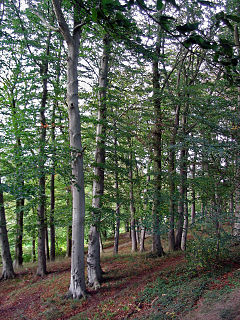
The Fagales are an order of flowering plants, including some of the best-known trees. The order name is derived from genus Fagus, beeches. They belong among the rosid group of dicotyledons. The families and genera currently included are as follows:

The Casuarinaceae are a family of dicotyledonous flowering plants placed in the order Fagales, consisting of four genera and 91 species of trees and shrubs native to eastern Africa, Australia, Southeast Asia, Malesia, Papuasia, and the Pacific Islands. At one time, all species were placed in the genus Casuarina. Lawrence Alexander Sidney Johnson separated out many of those species and renamed them into the new genera of Gymnostoma in 1980 and 1982, Allocasuarina in 1982, and Ceuthostoma in 1988, with some additional formal descriptions of new species in each other genus. At the time, it was somewhat controversial. The monophyly of these genera was later supported in a 2003 genetics study of the family. In the Wettstein system, this family was the only one placed in the order Verticillatae. Likewise, in the Engler, Cronquist, and Kubitzki systems, the Casuarinaceae were the only family placed in the order Casuarinales.
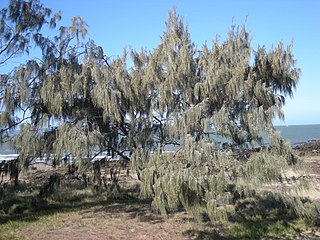
Casuarina equisetifolia, the Australian pine tree or whistling pine tree, is a she-oak species of the genus Casuarina. The native range extends throughout Southeast Asia, Northern Australia and the Pacific Islands; including Thailand, Myanmar, Vietnam, Malaysia, Singapore, Brunei, Indonesia, East Timor, and the Philippines, east to Papua New Guinea, French Polynesia, New Caledonia, and Vanuatu, and south to Australia. Populations are also found in Madagascar, but it is doubtful if this is within the native range of the species. The species has been introduced to the Southern United States and West Africa. It is an invasive species in Florida, South Africa, India and Brazil.

Allocasuarina is a genus of trees in the flowering plant family Casuarinaceae. They are endemic to Australia, occurring primarily in the south. Like the closely related genus Casuarina, they are commonly called sheoaks or she-oaks.

Casuarina is a genus of 17 tree species in the family Casuarinaceae, native to Australia, the Indian subcontinent, southeast Asia, islands of the western Pacific Ocean, and eastern Africa. It was once treated as the sole genus in the family, but has since been split into four genera.
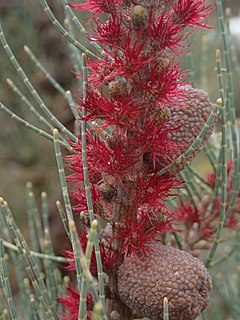
Allocasuarina humilis, commonly known as the dwarf sheoak or dwarf casuarina, is a woody shrub of the family Casuarinaceae endemic to the south-west of Western Australia.

Allocasuarina distyla, commonly known as scrub she-oak, is a shrub or small tree of the She-oak family Casuarinaceae endemic to New South Wales.
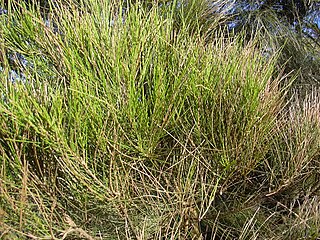
Casuarina glauca, commonly known as the swamp she-oak, swamp oak, grey oak, or river oak, is a species of Casuarina native to the east coast of Australia. It is found from central Queensland south to southern New South Wales. It has become naturalised in the Everglades in Florida where it is considered a weed.
Bull oak is a common name for a number of species of Australian trees. Some of the species involved are:

Gymnostoma sumatranum is a tree in the she-oak family, Casuarinaceae, native to Southeast Asia and the Malesia region.

Casuarina pauper is a tree from the family Casuarinaceae, native to a band across the drier, inland areas of southern Australia. C. pauper is known as a poorer, stunted form of the closely related Casuarina cristata . Common names include black oak and belah.

Allocasuarina inophloia, also known as woolly oak, or stringybark she-oak, is a shrub or small tree of the she-oak family Casuarinaceae endemic to inland New South Wales and Queensland. The hairy bark is an unusual feature.
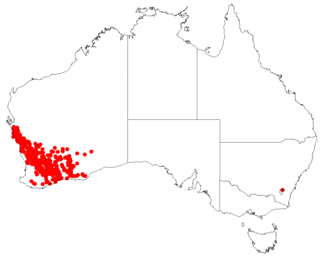
Allocasuarina campestris, commonly known as the Shrubby she-oak, is a shrub of the she-oak family Casuarinaceae native to Western Australia.

Allocasuarina decussata, commonly known as karri oak or karri she-oak, is a medium-sized tree, or more rarely a shrub, that is endemic to the south west of Western Australia. It is an understory tree in karri forest but also occurs as a stunted shrub in places like Bluff Knoll in the Stirling Range.

Allocasuarina striata, commonly known as the small bull oak, stalked oak-bush or the tall oak-bush, is a shrub of the genus Allocasuarina native to South Australia.
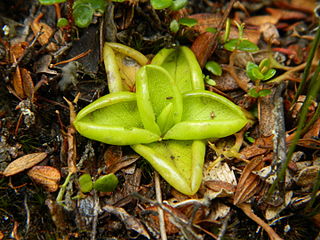
Pinguicula antarctica is a species of carnivorous plant from the genus Pinguicula, family Lentibulariaceae, described by Vahl.
Disepalum is a genus of plants in the family Annonaceae and tribe Annoneae.
Quercus treubiana is a member of the Quercus (oak) genus, in the section Cyclobalanopsis. It is found in the tropical mountain forests of Borneo and Sumatra at altitudes between 600 and 2200m. It is named for Melchior Treub, 1851–1910, who was until 1909 Director of the Bogor Botanical Gardens, Indonesia. It was first formally named by Karl Otto von Seemen in 1906 in the Bulletin de Département de l’Agriculture aux Indes Néerlandaises. It is also been referred to as Cyclobalanopsis treubiana (Seemen).
Elettariopsis smithiae is a monocotyledonous plant species described by Yee Kiew Kam. Elettariopsis smithiae belongs to the genus Elettariopsis and the family Zingiberaceae. No subspecies are listed in the Catalog of Life.














